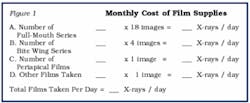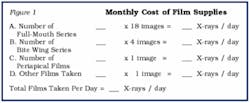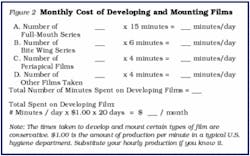The Internet: "Diagnosis: Digital"
"I'm going digital!" This phrase is becoming more common for women dentists who use technology to make their lives easier! Digital diagnostics have the advantage of less radiation, while providing immediate images that can be transmitted easily for patients, insurance companies, and consulting specialists.
No longer the purview of "techno-geek" dentists, digital technology is becoming a natural for streamlining the dental office. Initially introduced in France in the late 1980s, today's digital radiography has made vast improvements over those large, expensive, unreliable systems available back then. Technological breakthroughs in sensors and software have resulted in digital images that are at least as good, if not better, than those of X-ray film. With enlarged image size and enhancement tools, digital images provide superior diagnostic quality.
Here are some other benefits of digital radiography:
- Less radiation exposure to patients
- Instant on-screen images
- Rapid and superior diagnoses
- Image enhancement capabilities (such as magnification, contrast, and coloring)
- Improved patient acceptance and education
- Total elimination of darkroom, chemicals, and film
- Easy image sharing with other dentists or third-party payers
Many practitioners use digital radiography as a communication tool with patients as active co-participants in prevention, co-diagnosis, treatment, and maintenance. Your patients can now visualize their own oral health conditions in the digital age. Here are some other facts about the advantages of digital radiographs over conventional dental radiographs:
- Digital radiographs require approximately 75 percent less radiation than film to create an image.
- No chemicals are used in developing the images. You have no more worries about staining clothes or exposing staff to noxious chemicals or hassles with chemical disposal.
- The images your patients see of their teeth are instantly displayed on the television screen. Reviewing the teeth and supporting bone can occur simultaneously with oral examinations. Existing or potential problems can be discussed with treatment alternatives without waiting for film processing.
- Once an image is digitized, it can be manipulated electronically. Images can be enlarged and areas enlarged to bring out greater detail. Most software will also allow you to enhance images in other ways or email images to specialists and third-party insurance companies.
In Oct. 2002, Reality Publishing Company conducted a focus group of four women to assess the acceptability of digital radiographs. All four participants preferred the digital radiographs, citing the following reasons: ease of use, speed, comfort, ability to manipulate images to give a close-up view of the problem, the ability to change color to better illustrate problems, clear images, and less radiation. Participants stated that they thought all dentists should have digital radiography and were willing to pay $30 extra. The majority said they would be more motivated to pursue dental treatment after seeing their own digital X-rays. (Reality 2003; 17:308,317; authored by Dr. Michael Miller) How much does digital radiography cost? First, let's address the cost of traditional radiography:
- Fixed costs: conventional radiography equipment, stabilization in the wall for mounting, darkroom space, and a film processor. These items tend to be fairly large capital investments.
- Variable costs: the cost of films, mounts, and chemicals (e.g., developer, fixer, waste disposal). Also consider the staff cost for processing chemicals, disposing of chemicals, as well as developing and mounting films.
- Operatory costs: costs of your time, your staff's time, and even operatory time while films are being developed.
See Figures 1 and 2 for a simple worksheet to help estimate the cost of digital vs. conventional. Consider sharing the worksheet at an office meeting to involve your team members in decision making.
To determine the cost of taking film-based radiographs in your practice, add the results from Figures 1 and 2. Most dental practices spend $300 to $500 per month on the variable costs alone.
While there are costs involved in taking digital X-rays, the main difference is that there are no recurring, disposable items to purchase with digital radiography. The lifelong costs of film, mounts, and chemicals are gone! And team member costs are dramatically reduced since images are created instantaneously. The main costs for digital radiography are for initial purchase of the electronic sensor and capture device, the use of a computer and monitor, and the software. An annual maintenance contract may also add $1,000 to $1,500 per year.
How you purchase a digital radiography system is an important decision. Some doctors like to purchase their system outright and have very low costs going forward. Other doctors like to lease. Either way is highly comparable to the monthly cost of film-based radiographs. When you add in the cost of having highly skilled personnel mix chemicals and process films, going digital makes sense.
Digital radiography can have a huge impact in all areas of dentistry:
Dental Hygiene — Digital radiography saves team members five to 10 minutes of developing time from conventional film, allowing more time for treatment or education.
Emergency Dentistry — Time is saved by avoiding retakes of poorly placed films and taking additional films when needed.
Endodontics — Good quality radiographs are obtained in very short periods of time.
Crown and Bridge — These instantaneous images can be used to check the fit of new crowns, bridges, posts, and implant impression copings and abutments.
Periodontics — Digital images can help to determine bone levels and progression of bone loss by providing a series of successive images on one screen at one time.
Consultations — Images can be used for discussing diagnostic findings and case presentations.
Return on investment for this technology is more than just the money saved on purchasing film and developing chemicals. The bottom line is that digital radiography simply makes both good diagnostic and good financial sense.
Jeff Dalin, DDS
Dr. Dalin is a Fellow in the American and International Colleges of Dentists and the Academy of General Dentistry. He practices general dentistry in St. Louis, Mo., and is editor of St. Louis Dentistry Magazine. Contact him at [email protected] or (314) 567-5612.



